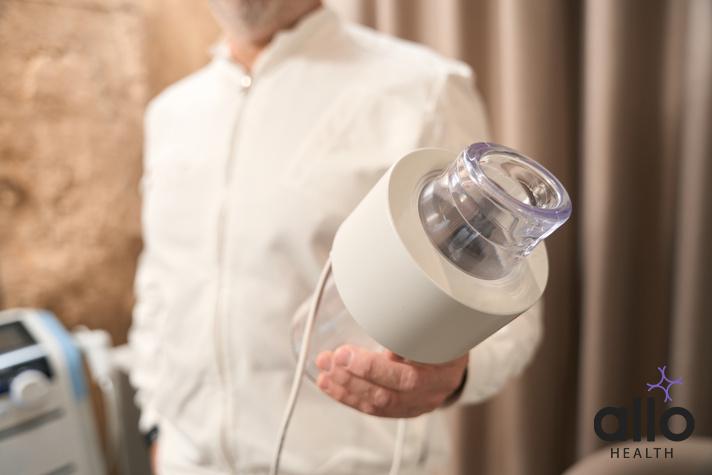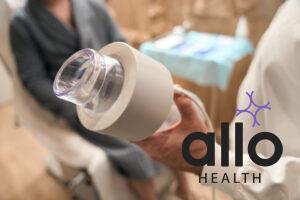Vacuum Erection Devices: How Do They Work?

Allo Health is dedicated to personalized well-being, offering support and trusted information tailored to individual health goals. The platform emphasizes human-generated content, led by a distinguished medical team of experts, including physicians and sexual health specialists. Their commitment to credibility involves rigorous fact-checking, authoritative research, and continuous updates to ensure accurate, up-to-date information. Allo Health's unique approach goes beyond conventional platforms, providing expert-led insights and a continuous commitment to excellence, with user feedback playing a crucial role in shaping the platform's authoritative voice.

Dr. Aditi completed her undergraduate medical education at AJIMS, Mangalore, after which she worked in multi-speciality hospitals with COVID patients and in the Pain and Palliative medicine department. Driven by her experiences, she developed a keen interest in psychiatry. Dr. Aditi believes that mental health is just as, if not more important, than physical health.
Why This Was Upated?
Our experts continually monitor the health and wellness space, and we update our articles when new information became available.
Updated on 29 May, 2024
- Article was updated as part of our commitment to diversity, equity, and inclusion.

"The following blog article may discuss medical treatments and interventions. However, it is important to note that the information provided is for general educational purposes only and should not be considered as a substitute for professional medical advice, diagnosis, or treatment. Always seek the guidance of a qualified healthcare professional for personalized medical advice.
Book consultation
Medical treatments are complex and should be tailored to individual circumstances. The information presented in this blog may not be applicable to everyone, as each person's medical condition, history, and needs are unique. Only a qualified healthcare professional can evaluate your specific medical situation, consider relevant factors, and provide appropriate recommendations for diagnosis, treatment options, and monitoring.
It is crucial to note that self-diagnosis, self-medication, or relying solely on the information provided in this blog for treatment decisions can have serious health consequences. "
Erectile dysfunction (ED) is a common problem that affects millions of men worldwide. Fortunately, there are various treatment options available, including the use of vacuum erection devices (VEDs).
In this comprehensive guide, we will explore everything you need to know about VEDs, how they work, and the benefits they offer.
What is Vacuum Erection Device?
- A Vacuum Erection Device (VED), also known as a vacuum pump or penis pump, is a non-invasive medical device designed to help men with erectile dysfunction (ED) achieve and maintain an erection.
- It consists of a plastic cylinder that is placed over the penis, a hand pump or battery-operated pump that creates a vacuum inside the cylinder, and a constriction ring or band that is placed at the base of the penis to maintain the erection once achieved.
- The vacuum created by the device draws blood into the penis, facilitating an erection.
- VEDs are considered a safe and effective option for many men with ED who prefer a non-pharmacological approach or for those who do not respond well to medications.
- They are typically recommended and prescribed by healthcare providers.
How Does a Vacuum Erection Device (VED) Work?
A Vacuum Erection Device (VED) typically consists of the following components:
- Cylinder: This is a clear, plastic tube that is placed over the penis. It comes in various sizes to accommodate different individuals.
- Pump: The pump creates a vacuum within the cylinder. It can be operated manually with a hand pump or electronically with a battery-powered pump.
- Constriction Ring or Band: This is a flexible ring, usually made of silicone or rubber, that is placed at the base of the penis after achieving an erection. It helps maintain the erection by preventing blood from flowing out of the penis.
- Tubing (if applicable): In some models, there may be a connecting tube that links the cylinder to the pump.
- Release Valve (if applicable): Some devices have a release valve to quickly release the vacuum and remove the device.
- Safety Features: Some VEDs come with safety features to prevent excessive pressure and allow for controlled use.
VEDs are available in various models and brands, and their specific design and features may vary. It’s important for individuals to receive proper instruction from their healthcare provider on how to use and maintain the device.
How to Use a VED?
Prepare the Device: Ensure that all components of the VED are clean and in good condition. Connect the pump to the cylinder and make sure there are no air leaks.
Apply Lubrication: Apply a water-based lubricant to the base of your penis. This helps create a better seal between the cylinder and your skin.
Insert Your Penis: Gently insert your flaccid penis into the cylinder.
Create a Seal: Hold the cylinder firmly against your body to create a seal. This prevents air from entering and allows for proper suction.
Pump the Device: Begin pumping the air out of the cylinder using the hand pump. This creates a vacuum, causing blood to flow into the penis and create an erection.
Monitor Pressure: Be cautious not to over-pump. Stop if you experience any discomfort.
Maintain Erection: Once you’ve achieved an erection, you can use a constriction band (included with some VED kits) at the base of the penis to help maintain it.
Remove the Device: After intercourse or when you no longer need the erection, release the vacuum by pressing the release valve on the pump.
Clean and Store: Clean the device thoroughly with warm water and mild soap. Allow it to air dry before storing it in a clean, dry place.
Safety Precautions: Follow the manufacturer’s instructions carefully and don’t use the device for longer than recommended. If you experience pain, discomfort, or any adverse effects, discontinue use and consult a healthcare professional.
Remember, it’s important to consult with a healthcare provider before using a VED, especially if you have any underlying medical conditions or take medications that may interact with this device.
They can provide personalised advice and ensure it’s safe and suitable for your specific situation.

Side Effects of Using a Vacuum Erection Device (VED)
While a Vacuum Erection Device (VED) is generally considered safe and effective, there are some potential side effects to be aware of:
Discoloration and Temperature Changes:
- After applying the constriction band, you may observe a slight bluish or purplish hue in the color of the penis.
- Additionally, it might feel cooler than usual.
- This is a normal reaction due to restricted blood flow. To alleviate this, consider applying a warm compress to the area before engaging in sexual activity.
- These effects typically subside once the band is removed.
Absence of Ejaculation at Climax:
- Due to the presence of the constriction band, ejaculation may not occur during climax.
- This is a temporary effect and is not a cause for concern.
- Once the band is removed, semen may gradually be expelled from the penis.
- However, it’s crucial to understand that the band should never be relied upon as a form of birth control.
Petechiae and Bruising:
- In some cases, individuals may notice small red spots under the skin (known as petechiae) or experience minor bruising on the penis.
- This could be an indication of applying excessive pressure or having the band too tight.
- In such instances, it is recommended to cease using the device until these effects have completely dissipated, which usually takes around five days.
It’s essential to use the VED responsibly and in accordance with the provided instructions. If you experience any severe or persistent side effects, it’s advisable to consult a healthcare professional for guidance and support.
Regular check-ins with a healthcare provider can ensure that the device is being used safely and effectively as part of your treatment plan.
When to Use Vacuum Erection Devices (VEDs)?
A Vacuum Erection Device (VED) can be a valuable tool for men experiencing Erectile Dysfunction (ED) under various circumstances. Here are common situations where using a VED might be recommended:
- Underlying Medical Conditions: Men with medical conditions that can lead to blood flow or nerve issues, such as diabetes, heart disease, or nervous system disorders, may find VEDs particularly beneficial. These devices can help improve blood flow to the penis, facilitating erections.
- Medication-Induced ED: Some medications, including certain antidepressants and blood pressure drugs, can contribute to ED. In such cases, using a VED can be an effective non-pharmaceutical approach to overcoming this side effect.
- Post-Prostate Surgery or Spinal Cord Injury: Nerve damage resulting from prostate surgery or a spinal cord injury can impede the body’s natural ability to achieve and maintain an erection. VEDs offer a mechanical solution by creating a vacuum that draws blood into the penis, enabling an erection.
- Psychological or Relationship Factors: Emotional and relationship concerns like depression, anxiety, or difficulties in communication with a partner can contribute to ED. In these situations, a VED can serve as a practical aid, helping to restore confidence and intimacy.

While VEDs are generally considered safe, it is crucial to consult with a healthcare professional before using one, especially if you:
Have a Bleeding Disorder: Individuals with conditions like sickle cell disease, which affect blood clotting, should exercise caution when considering the use of a VED. Consulting a healthcare provider is essential to ensure safe usage.
Are Prone to Priapism: Priapism is a condition characterised by a prolonged and often painful erection that doesn’t subside naturally. If you have any medical conditions that may predispose you to priapism, it’s important to discuss the use of a VED with your doctor.
Take Blood-Thinning Medications: If you are currently taking medications that thin the blood, it’s crucial to consult your healthcare provider. They can provide guidance on the safe use of a VED in conjunction with your existing medication regimen.
Remember, seeking professional advice and guidance is paramount when considering the use of a VED. A healthcare provider can offer personalised recommendations based on your specific medical history and condition.
What is ED and its Potential Causes?
Erectile Dysfunction (ED), often referred to as impotence, is a condition characterized by the consistent inability to achieve or maintain an erection sufficient for sexual intercourse. This can be a source of significant distress and can impact overall well-being.
Causes of ED can be diverse:
- Medical Conditions: Diabetes, heart disease, high blood pressure, and neurological disorders can disrupt blood flow or nerve function necessary for achieving an erection.
- Medications: Some drugs, particularly those for blood pressure, antidepressants, and certain medications for prostate conditions, can contribute to ED.
- Psychological Factors: Stress, anxiety, depression, and relationship issues can lead to or exacerbate ED. These factors can create a mental barrier that inhibits sexual performance.
- Trauma or Injury: Physical injury to the pelvic area or spinal cord can affect the nerves and blood vessels involved in the erection process.
- Lifestyle Choices: Smoking, excessive alcohol consumption, and drug use can all have detrimental effects on blood flow and overall sexual health.
- Hormonal Imbalance: Low levels of testosterone or other hormonal imbalances can contribute to ED.
- Age and Aging Process: As men get older, the risk of ED increases. It’s a natural part of aging, but it can also be influenced by other health factors.
- Psychiatric Conditions: Conditions like schizophrenia or bipolar disorder, as well as the medications used to treat them, can impact sexual function.
Key Takeaways:
- Erectile Dysfunction (ED) is a widespread issue affecting millions of men globally. Various treatments, including Vacuum Erection Devices (VEDs), are available.
- A Vacuum Erection Device (VED) is a non-invasive medical tool designed to assist men with ED. It comprises a plastic cylinder, a pump, and a constriction ring to facilitate and maintain erections.
- The device operates by creating a vacuum, drawing blood into the penis, leading to an erection. VEDs are recommended and prescribed by healthcare providers.
- Proper use of a VED involves preparing the device, applying lubrication, inserting the penis, creating a seal, pumping, monitoring pressure, maintaining the erection, and removing and storing the device.
- Side effects of VED use may include temporary discoloration, absence of ejaculation, and potential bruising. These effects typically subside after discontinuing use.
- VEDs are suitable for men with medical conditions affecting blood flow or nerves, medication-induced ED, post-prostate surgery or spinal cord injury, and those facing psychological or relationship challenges. Consultation with a healthcare provider is crucial for safe usage, especially for individuals with specific medical conditions.
Frequently Asked Questions
Q: What is a Vacuum Erection Device (VED)?
A: A Vacuum Erection Device, also known as a penis pump or vacuum constriction device, is a non-invasive medical tool designed to help men with erectile dysfunction achieve and maintain an erection.
Q: What are the other names for vacuum erection device?
A: A Vacuum Erection Device (VED) is also known as a Vacuum Constriction Device (VCD) and colloquially referred to as a Penis Pump. It is used to address erectile dysfunction and is sometimes mentioned under these alternative names.
Q: Are VEDs safe to use?
A: Yes, VEDs are considered safe when used correctly. However, it’s crucial to follow the provided instructions and consult with a healthcare provider, especially if you have specific medical conditions.
Q: Is a prescription required to obtain a VED?
A: In many cases, a prescription from a healthcare provider is required to obtain a VED. They will assess if it’s a suitable option based on your medical history.
Q: How often can I use a VED?
A: It’s generally recommended to allow at least 60 minutes between uses of a VED. Overuse could potentially lead to discomfort or other complications.
Q: Can a VED be used alongside other ED treatments?
A: Yes, a VED can be used in combination with other treatments like medication or lifestyle changes. It’s important to discuss this with your healthcare provider to ensure a safe and effective approach.




































